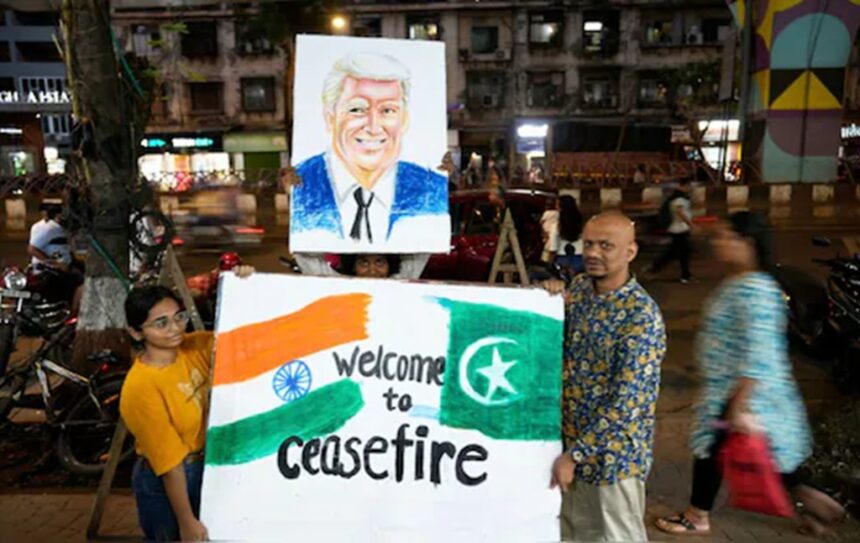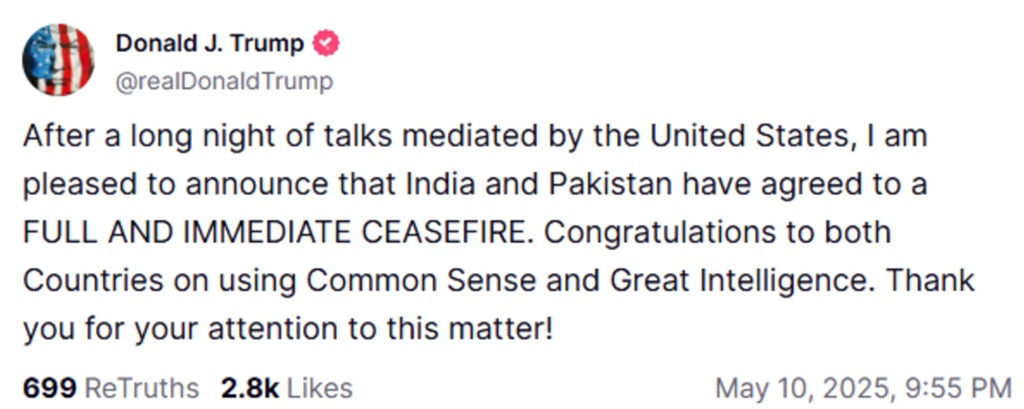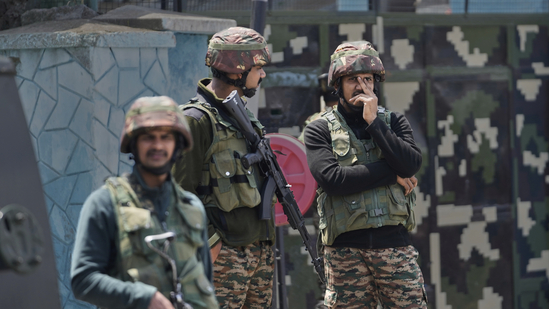On May 10, 2025, U.S. President Donald Trump declared that India and Pakistan had agreed to a “full and immediate ceasefire.” He credited the news to U.S.-led talks and posted the announcement on Truth Social.
This followed a wave of clashes between the two nuclear-armed countries, raising fears of a much bigger conflict over Kashmir. Yet, within hours, explosions hit Indian-controlled Kashmir and both sides accused each other of breaking the truce, casting doubt on how long the calm would last and how much the U.S. was truly involved.
The recent crisis began on April 22, 2025, after a terrorist strike in Pahalgam, located in Indian-administered Kashmir. The attack killed 26 people, most of them tourists. Indian officials blamed Pakistan, arguing the group behind the attack had ties to Lashkar through the Resistance Front (TRF). Pakistan denied any link.
India answered with “Operation Sindoor,” launching air raids on what it said were terrorist bases inside Pakistan and in Pakistan-administered Kashmir. Pakistan hit back with “Operation Bunyan-al-Marsoos,” targeting Indian military sites, including missile depots, with drones and missiles.
By May 10, both sides had stepped up their attacks, targeting each other’s air bases and civilian areas—a level of violence not seen since the 1999 Kargil War. At least 13 civilians died in Pakistani-held Kashmir, and over 50 people were hurt across the region. Concerns about nuclear escalation rose after Pakistan’s army hinted at a meeting of its nuclear command, though officials later denied such talks had taken place.
Kashmir has been a point of tension since India and Pakistan split in 1947. Both countries claim all of Kashmir but only control parts. Years of war, rebellion, and broken talks have deepened mistrust.
In India, Prime Minister Narendra Modi faces pressure to look tough on terrorism. In Pakistan, Prime Minister Shehbaz Sharif manages a shaky alliance and deals with a military that holds power behind the scenes.
Trump Announces Ceasefire
Trump’s statement surprised many, especially after Vice President JD Vance told Fox News the dispute was “fundamentally none of our business.” Despite that, Trump claimed, “After a long night of talks mediated by the United States, I am pleased to announce that India and Pakistan have agreed to a FULL AND IMMEDIATE CEASEFIRE. Congratulations to both countries on using common sense and great intelligence.”
Reports said Secretary of State Marco Rubio and Vance spoke with top leaders from both India and Pakistan, including Modi and Sharif, over two days. Rubio said the deal included plans for bigger talks at a neutral location, but India later denied such a plan. Pakistan welcomed the U.S. role, with Sharif saying American mediation was “pivotal and paramount.”
India’s Foreign Secretary Vikram Misri played down U.S. involvement. He said the truce was made directly between the two militaries after Pakistan’s Director General of Military Operations called his Indian counterpart. This has raised doubts about how much credit Trump and his aides should get for the ceasefire.
This ceasefire comes at a time of heavy political and international pressure. Trump has built his image as a dealmaker since his first term. His team saw a chance to step in, especially as the U.S. looks to strengthen its partnership with India to check China’s influence. America has boosted trade and military deals with India, while Pakistan’s economy depends on support from the U.S. and the IMF.
Still, the U.S. response shifted from Vance’s earlier “hands-off” stance, likely because of the conflict’s rapid escalation and widespread concern. Countries like Saudi Arabia, Turkey, China, and the G7 also called for calm, pushing Washington to act.
Modi’s government came under fire for its strong response, including putting the Indus Waters Treaty on hold, which is important for Pakistan’s farmers. The ceasefire lets him appear strong while avoiding a drawn-out conflict that could hurt the economy. On the other side, Sharif took credit for what he called Pakistan’s success in quieting Indian attacks, hoping to boost his image at home.
India and Pakistan on Shaky Ground
Just a few hours after the truce took hold at 5 p.m. local time, explosions shook Srinagar and Jammu in Indian-administered Kashmir. Jammu and Kashmir’s chief minister, Omar Abdullah, posted on X about the blasts, asking what happened to the ceasefire. India accused Pakistan of repeated breaches, with Misri saying the Indian army was firing back. Pakistan’s foreign ministry blamed India for the violations and called for restraint.
Analysts say the ceasefire is unstable. Unless Kashmir’s status and cross-border militancy are addressed, the truce is just a temporary break. A CNN report noted the deal would not fix the deep problems that have fueled the dispute for decades. Previous ceasefires, like the one from 2003, also fell apart under similar strain.
The next round of talks between the military chiefs is set for May 12, but India’s refusal to consider wider talks makes any long-term peace look unlikely. People living near the Line of Control are worried. In Indian-held Kashmir, lawyer Aaqib Ahmed told The Washington Post he would not feel safe until the shooting stops for good. In Rawalpindi, Pakistan, Rahat Anwaar Abbasi described a sleepless night due to heavy blasts.
Trump’s push may have prevented a larger war, but unclear details about U.S. involvement and quick violations point to a rushed deal. Was this a real diplomatic win or an attempt by Trump to boost his legacy? The answer seems mixed, with competing interests, political moves, and the unsolved Kashmir dispute all in play.
Related News:
India-Pakistan Conflict Escalates as China Works Covertly in the Background
















